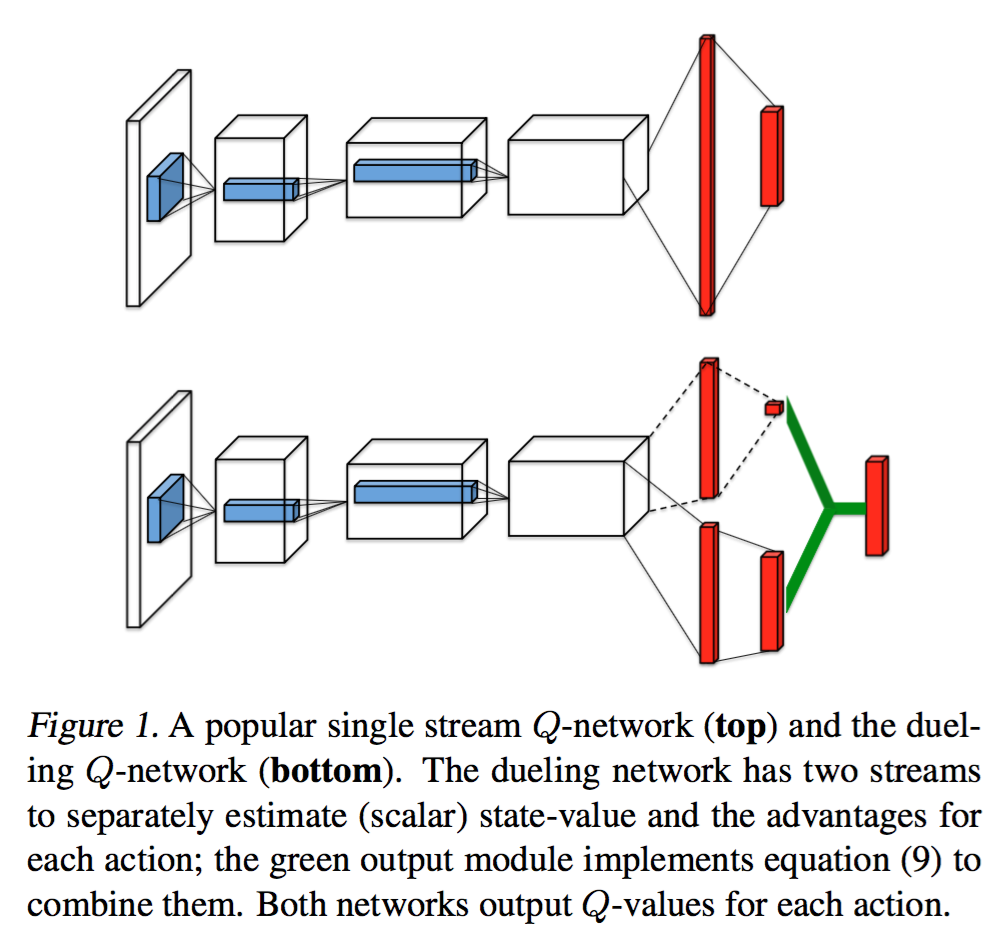关于
强化学习是未来很重要的方向!参考 Alpha Go!
Markov Decision Process
- A set of states $(s \in S)$
- A set of actions $(a \in A)$
- A transition function $(T(s, a, s'))$
- 转移概率 $(P(s'| s, a))$
- 也叫 model 或者 dynamics
- A reward function $(R(s, a, s'))$
- 通常只是状态的函数$(R(s), R(s'))$
- 一个初始状态
- 一个终止状态
MDP 不是一个确定性的搜索问题,一种方法是 期望值最大搜索 ?!
马尔科夫性说的是未来的决策与过去无关,至于当前状态和策略有关!
(最优)策略:$(\pi^* : S \rightarrow A)$
状态转移函数 $(T(s, a, s') = p(s'| s, a))$
discounting reward: $(r_0 + \gamma r_1 + \gamma^2 r_2 + ...)$
当 $(\gamma < 1)$时,discounting reward 有界 $(R_{max}/(1-\gamma))$!
或者采用 finite horizon,当迭代到 T 步时,停止!
-
MDP quantities:
- Policy = 对每一个状态选择一个action
- Utility = sum of (discounted) rewards
-
状态 value function: $(V^* (s))$
- q-state (s, a), $(Q^* (s,a))$
-
最优策略 $(\pi^* (s))$
-
递归定义:
- $(V^ * (s) = \max_a Q^ * (s, a))$
- $(Q^ * (s, a) = \sum_{s'} (s, a, s') \left[ R(s, a, s') + \gamma V^* (s') \right])$
- $(V^ * (s) = \max_a \sum_{s'} (s, a, s') \left[ R(s, a, s') + \gamma V^* (s') \right])$
-
Time-limited value: 定义$(V_k(s))$ 为状态s下,最多k步下的最优value
- Value iteration:
- $(V_0(s) = 0)$
- $(V_{k+1}(s) \leftarrow \max_a \sum_{s'} (s, a, s') \left[ R(s, a, s') + \gamma V_k^* (s') \right]) )$
- 重复1-2直到收敛!
- 复杂度,每次迭代 $(O(S^2A))$
- 收敛到唯一最优值!贝尔曼算子在 $(\gamma<1)$时时压缩算子,所以必收敛到不动点。
- Policy iteration
- 随机化策略$(\pi)$
- Policy evaluation:对给定的策略 $(\pi)$,利用迭代或者线性方程求解的方法计算该策略下的值函数,即求解下面第一个方程。因为该方程是一个关于值函数的线性方程,所以对于有限状态的情况可以直接求解线性方程,或者利用迭代求解。
- Policy improvement:对上述值函数,利用贝尔曼方程求出最优策略。重复2-3多次直到收敛,收敛条件是策略不改变了。
实际上,它是在交替迭代策略和值函数。这种方法可以保证每次迭代值函数单调不减,又因为有界所以收敛。
$$
V^{\pi_i}(s) = r(s, \pi_i(s)) + \gamma \sum_{s' \in S} p(s'|s, \pi_i(s)) V^{\pi_i}(s') \\
\pi_{i+1}(s) = \arg \max_a r(s, a) + \gamma \sum_{s' \in S} p(s'|s, a) V^{\pi_i}(s')
$$
Reinforcement Learning
仍然是一个MDP过程,仍然寻找最优决策!
但是不知道状态转移函数T 和 回报函数 R!
- MDP:Offline
- RL:Online
model-based Learning
通过经验,学习一个近似模型,然后求解!
- Step1:学习经验MDP模型:
- 对每一个个(s, a)统计s'
- 归一化得到$(\hat{T}(s, a, s'))$
3.
深度强化学习tutorial@ICML2016
AI = RL + DL
- 值函数
- 策略
- 状态转移模型
使用深度学习建模值函数,策略和模型!
Value-Based Deep RL
Q-Networks
$$
Q(s, a, w) \approx Q^* (s, a)
$$
Q-Learning:
最优 Q-value 应该遵循 Bellman 方程
$$
Q^ * (s, a) = \mathbb{E}_{s'} \left[ r + \gamma \max_{a'} Q(s', a')^ * |s, a \right]
$$
其中 s 表示状态,a 表示agent对环境做出的 action!
将方程右边当做目标,用神经网络学习!
损失函数:
$$
l = (r + \gamma \max_{a'} Q(s', a', w) - Q(s, a, w) )^2
$$
问题:1. 训练样本不是 iid; 2. 目标不稳定!
DQN:利用 agent 自身经验构建样本!
$$
l = \left(r + \gamma \max_{a'} Q(s', a', w^-) - Q(s, a, w) \right)^2
$$
在某一次replay 的更新中,$(w^-)$是固定的!replay结束后,将线上的权值$(w)$更新到$(w^-)$
Double DQN
- 当前的 Q-network w 用来选择 action
- 老的 Q-network w- 用来评估 action
$$
a^* = \arg\max_{a'} Q(s', a', w) \\
l = \left( r + \gamma Q( s', a^ * , w^- ) - Q(s, a, w) \right)^2
$$
Prioritised replay
按照 TD-error 对 replay memory 中的样本进行 importance sampling。
$$
\delta = \left| r + \gamma \max_{a'} Q(s', a', w^-) - Q(s, a, w) \right| \\
P(i) = \frac{p_i^{\alpha}}{\sum_k p_k^{\alpha}} \\
p_i = \delta_i + \epsilon
$$
Duelling network
将 Q 函数分解为状态值函数与 advantage function(不知道怎么翻译) 之和。
$$
Q(s,a; \theta, \alpha, \beta) = V(s; \theta, \alpha) + A(s,a; \theta, \alpha)
$$
上式V和A之间是不定的,可以相差一个任意常数,不影响结果。为此,有两种解决方案,减最大值和平均值。
平均值方案更加稳定,因为V只需要跟踪平均波动,而不是最大波动。
$$
Q(s,a; \theta, \alpha, \beta) = V(s; \theta, \alpha) + \left( A(s,a; \theta, \alpha) - \max_{a'\in \mathcal{A}} A(s,a'; \theta, \alpha) \right) \\
Q(s,a; \theta, \alpha, \beta) = V(s; \theta, \alpha) + \left( A(s,a; \theta, \alpha) - \frac{1}{|\mathcal{A}|} \sum_{a'} A(s,a'; \theta, \alpha) \right)
$$

Deep Policy Networks
用神经网络建模策略函数
$$
a = \pi(a| s, \mathbf{u}) = \pi( s, \mathbf{u})
$$
目标函数为total discounted reward
$$
J(u) = \mathbf{E}(r_1 + \gamma r_2 + \gamma^2 r_3 + ... | \pi(., u))
$$
令$(\tao = (s_1, a_1, ..., s_t, a_t))$代表状态-动作路径,用$(r(\tao))$代表每个路径的折扣reward,那么期望回报函数
$$
J(\theta) = \int \pi_{\theta}(\tao) r(\tao) d\tao
$$
对参数$(\theta)$求导,由于回报函数与参数无关,所以梯度只作用与策略函数
$$
\nabla_{\theta} J(\theta) = \int \nabla_{\theta} \pi_{\theta}(\tao) r(\tao) d\tao =\int \pi_{\theta}(\tao) \nabla_{\theta} \log \pi_{\theta}(\tao) r(\tao) d\tao = E_{\tao ~ \pi_{\theta}(\tao)} \nabla_{\theta} \pi_{\theta}(\tao) r(\tao)
$$
利用马尔科夫性,
$$
\log \pi_{\theta}(\tao) = \log p(s_1) + \sum_{t=1}^T \left[\log \pi_{\theta}(a_t|s_t) + \log p(s_{t+1}|s_t, a_t) \right]
$$
代入上式可得
$$
\nabla_{\theta} J(\theta) = E_{\tao ~ \pi_{\theta}(\tao)} \sum_{t=1}^T \nabla_{\theta}\log \pi_{\theta}(a_t|s_t) r(\tao)
$$
如果把策略函数看做在状态s下选择动作a的概率,回报是该样本的权重!即加权极大似然估计!
相关资料
- 强化学习书籍:https://webdocs.cs.ualberta.ca/~sutton/book/ebook/the-book.html
- Tutorial: Deep Reinforcement Learning, ICML 2016. David Silver, Google Deepmind.
- CS234: Reinforcement Learning http://web.stanford.edu/class/cs234/index.html
- Berkeley 课程:CS 294: Deep Reinforcement Learning. http://rll.berkeley.edu/deeprlcourse/
- http://ai.berkeley.edu/course_schedule.html